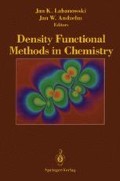Abstract
The chemistry of the actinide elements continues to present challenges to both experimental and theoretical chemists. Actinide compounds have been found to possess a diversity of structures and reactivities that are not only extensions of but significant additions to those recognized for the transition metal elements.1 From a theoretical perspective, the number of electrons and the importance of relativistic corrections in actinide systems pose several problems: theoretical rigor is more difficult to maintain, calculations are more computationally demanding, and results are more difficult to interpret than those obtained from non-relativistic calculations. Nonetheless, significant advances have been made in the application of molecular electronic structure methods to actinide compounds. Local density functional (LDF) methods in particular have several features that make them attractive for the study of heavy element structure and bonding. We present here a brief description of a computational scheme that employs the LDF formalism to address questions in actinide electronic structure and then demonstrate its application to one system in particular: three-coordinate actinide(III) compounds.
Access this chapter
Tax calculation will be finalised at checkout
Purchases are for personal use only
Preview
Unable to display preview. Download preview PDF.
References
Katz, J. J.; Morss, L. R.; Seaborg, G. T., ed., The Chemistry of the Actinide Elements, Chapman and Hall, New York 1986.
Marks, T. J.; Fragalà, I. L., ed., Fundamental and Technological Aspects of Organo-f-Element Chemistry, Reidel, Dordrecht 1985.
Marks, T. J.; Ernst, R. D. in Comprehensive Organometallic Chemistry, Ch. 21, Wilkinson, G.; Stone, F. G. A.; Abel, E. W., ed., Pergamon Press, Oxford 1982.
Pyykkö, P. Chem. Rev. 1988, 88, 563–594.
Pitzer, K. S. Acc. Chem. Res. 1979, 12, 271–276.
Pyykkö, P.; Desclaux, J.-P. Acc. Chem. Res. 1979, 12, 276–281.
Schiff, L. I. Quantum Mechanics, 3rd. ed., McGraw-Hill, New York 1968.
Grant, I. P. Adv. Phys. 1970, 19, 747–811.
Grant, I. P. in Methods in Computational Chemistry, Vol. 2: Relativistic Effects in Atoms and Molecules, Ch. 1, Wilson, S. ed., Plenum Press, New York 1988.
Wilson, S. in Methods in Computational Chemistry, Vol. 2: Relativistic Effects in Atoms and Molecules, Ch. 2, Wilson, S. ed., Plenum Press, New York 1988.
Szabo, A.; Ostlund, N. Modern Quantum Chemistry, McGraw-Hill, New York 1989.
Desclaux, J.-P. Atom. Data Nucl. Data. Tables 1973, 12, 312–406.
Slater, J. C. Adv. Quantum Chem. 1972, 6, 1–92.
Rosen, A.; Ellis, D. E. Chem. Phys. Lett. 1974, 27, 595–599.
Rosen, A.; Ellis, D. E. J. Chem. Phys. 1975, 62, 3039–3049.
Powell, R. E. J. Chem. Ed. 1968, 45, 558–563.
White, H. E. Phys. Rev. 1931, 38, 513–520.
Averill, F. W.; Ellis, D. E. J. Chem. Phys. 1973, 59, 6412–6418.
Doris, K. A.; Delley, B.; Ratner, M. A.; Marks, T. J.; Ellis, D. E. J. Phys. Chem. 1984, 88, 3157–3159.
Ellis, D. E.; Goodman, G. L. Int. J. Quantum Chem. 1984, 25, 185–200.
Baerends, E. J.; Ellis, D. E.; Ros, P. Chem. Phys. 1973, 2, 41–51.
Delley, B.; Ellis, D. E. J. Chem. Phys. 1982, 76, 1949–1960.
Van Der Sluys, W. G.; Burns, C. J.; Sattelberger, A. P. Organometallics 1989, 8, 855–857.
Andersen, R. A. Inorg. Chem. 1979, 18, 1507–1509.
Van Der Sluys, W. G.; Burns, C. J.; Huffman, J. C.; Sattelberger, A. P. J. Am. Chem. Soc. 1988, 110, 5924–5925.
Brennan, J. G. Ph. D. Dissertation, University of California, Berkeley, 1985.
Quasi-relativistic Xα-SW calculations have been used extensively in the investigation of Cp3An and its adducts
Bursten, B. E.; Rhodes, L. F.; Strittmatter, R. J. J. Am. Chem. Soc. 1989, 111, 2758–2766.
Bursten, B. E.; Rhodes, L. F.; Strittmatter, R. J. J. Am. Chem. Soc. 1989, 111, 2756–2758.
Bursten, B. E.; Rhodes, L. F.; Strittmatter, R. J. J. Less Com. Met. 1989, 149, 207–211.
Bursten, B. E.; Strittmatter, R. J. J. Am. Chem. Soc. 1987, 109, 6606–6608.
Bursten, B. E.; Strittmatter, R. J., submitted for publication.
Ziegler, T. J. Am. Chem. Soc. 1983, 705, 7543–7549, and references therein.
In this paper, metal-based orbitals are denoted σ, π, δ, and φ in correspondence with their symmetry about the principle molecular axis. Further, in dealing with jj-coupled orbitals, we adhere to the notation 1 (or 1*) and 1 for the lower and higher j-valued functions, respectively, and append a subscript referring to mj if necessary. Refer to reference 9a for a clear introduction to these and related concepts.
Bursten, B. E.; Casarin, M.; DiBella, S.; Fang, A.; Fragalà, I. L. Inorg. Chem. 1985, 24, 2169–2173.
An An-H bond length of 2.0 Å was used in all the reported hydride results. Investigations of other bond lengths led to analogous conclusions.
Boerrigter, P. M.; Baerends, E. J.; Snijders, J. G. Chem. Phys. 1988, 122, 357–374.
The separation into metal manifolds of distinct orbital character is not entirely clean, due to higher-order mixing between orbitals of the same symmetry type. This mixing only clouds the overall picture and is not of any qualitative import.
Rösch, N. Inorg. Chim. Acta 1984, 94, 297–299.
Rösch, N.; Streitwieser, A. J. Am. Chem. Soc. 1983, 105, 7237–7240.
Rösch, N.; Streitwieser, A. J. Organomet. Chem. 1978, 145, 195–200.
Kot, W. K.; Shalimoff, G. V.; Edelstein, N. M.; Edelman, M. A.; Lappert, M. F. J. Am. Chem. Soc. 1988, 110, 986–987.
Bond lengths and angles used in the amide calculations: An-N = 2.32 Å, N-H = 1.01 Å, An-N-H = 120.0°.
Stewart, J. L. Ph. D. Dissertation, University of California, Berkeley, 1988.
Editor information
Editors and Affiliations
Rights and permissions
Copyright information
© 1991 Springer-Verlag New York, Inc.
About this chapter
Cite this chapter
Schneider, W.F., Strittmatter, R.J., Bursten, B.E., Ellis, D.E. (1991). Relativistic DV-Xα Studies of Three-Coordinate Actinide Complexes. In: Labanowski, J.K., Andzelm, J.W. (eds) Density Functional Methods in Chemistry. Springer, New York, NY. https://doi.org/10.1007/978-1-4612-3136-3_16
Download citation
DOI: https://doi.org/10.1007/978-1-4612-3136-3_16
Publisher Name: Springer, New York, NY
Print ISBN: 978-1-4612-7809-2
Online ISBN: 978-1-4612-3136-3
eBook Packages: Springer Book Archive

